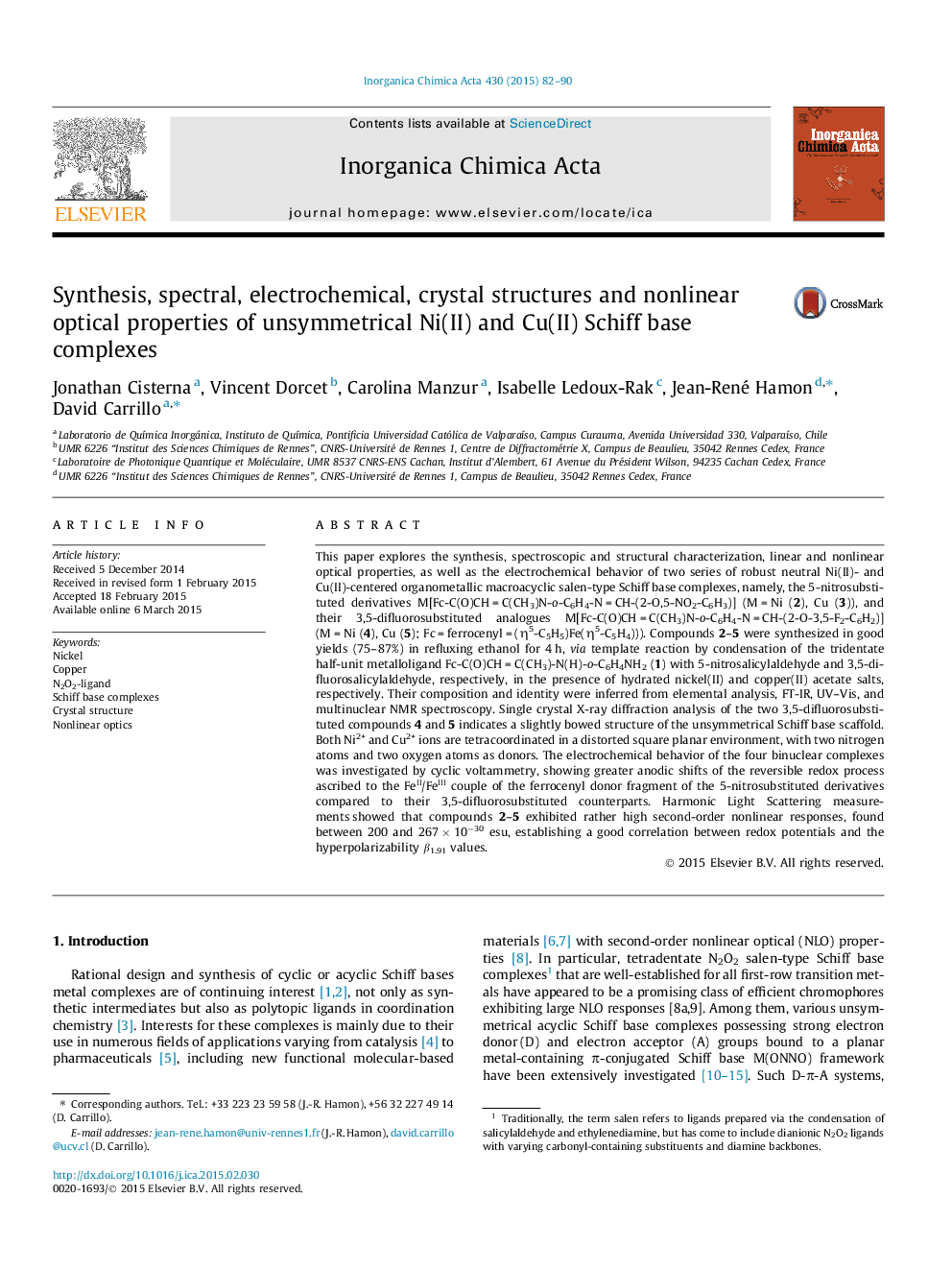| Article ID | Journal | Published Year | Pages | File Type |
|---|---|---|---|---|
| 1309112 | Inorganica Chimica Acta | 2015 | 9 Pages |
•Templated synthesis of push–pull robust Ni(II)- and Cu(II)–N2O2 Schiff base complexes.•Substitution of the salicylidene ring by 5-NO2 in a series and by 3,5-F2 in another.•Characterization by elemental analysis, absorption and multinuclear NMR spectroscopy.•X-ray crystal structure of both 3,5-difluorosubstituted Ni and Cu derivatives.•Correlation between the appended ferrocenyl redox potentials and NLO β1.91 values.
This paper explores the synthesis, spectroscopic and structural characterization, linear and nonlinear optical properties, as well as the electrochemical behavior of two series of robust neutral Ni(II)- and Cu(II)-centered organometallic macroacyclic salen-type Schiff base complexes, namely, the 5-nitrosubstituted derivatives M[Fc-C(O)CH = C(CH3)N-o-C6H4-N = CH-(2-O,5-NO2-C6H3)] (M = Ni (2), Cu (3)), and their 3,5-difluorosubstituted analogues M[Fc-C(O)CH = C(CH3)N-o-C6H4-N = CH-(2-O-3,5-F2-C6H2)] (M = Ni (4), Cu (5); Fc = ferrocenyl = (η5-C5H5)Fe(η5-C5H4))). Compounds 2–5 were synthesized in good yields (75–87%) in refluxing ethanol for 4 h, via template reaction by condensation of the tridentate half-unit metalloligand Fc-C(O)CH = C(CH3)-N(H)-o-C6H4NH2 (1) with 5-nitrosalicylaldehyde and 3,5-difluorosalicylaldehyde, respectively, in the presence of hydrated nickel(II) and copper(II) acetate salts, respectively. Their composition and identity were inferred from elemental analysis, FT-IR, UV–Vis, and multinuclear NMR spectroscopy. Single crystal X-ray diffraction analysis of the two 3,5-difluorosubstituted compounds 4 and 5 indicates a slightly bowed structure of the unsymmetrical Schiff base scaffold. Both Ni2+ and Cu2+ ions are tetracoordinated in a distorted square planar environment, with two nitrogen atoms and two oxygen atoms as donors. The electrochemical behavior of the four binuclear complexes was investigated by cyclic voltammetry, showing greater anodic shifts of the reversible redox process ascribed to the FeII/FeIII couple of the ferrocenyl donor fragment of the 5-nitrosubstituted derivatives compared to their 3,5-difluorosubstituted counterparts. Harmonic Light Scattering measurements showed that compounds 2–5 exhibited rather high second-order nonlinear responses, found between 200 and 267 × 10−30 esu, establishing a good correlation between redox potentials and the hyperpolarizability β1.91 values.
Graphical abstractTwo series of binuclear push–pull unsymmetrical Schiff base complexes were synthesized and fully characterized. Those D-π-A conjugated systems that are all redox active and exhibit high thermal stability and good second-order NLO responses, contain a ferrocene donor linked to acceptor 5-NO2 or 3,5-F2 substituted salicylidene through a central M(N2O2) core (M = Ni, Cu).Figure optionsDownload full-size imageDownload as PowerPoint slide
